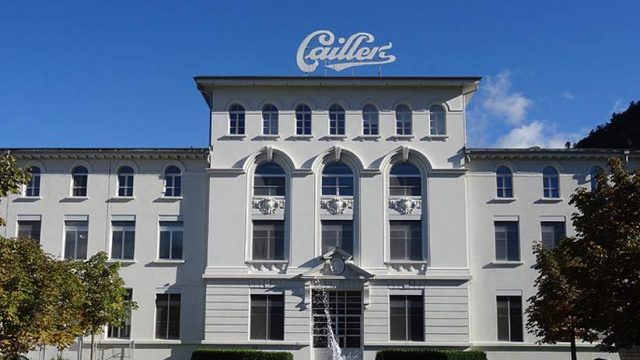It’s not quite Willy Wonka’s chocolate factory, though it comes close. There are no Oompa-Loompas or pale-as-winter-snow Johnny Depp, but you can expect rich cocoa, the best quality nuts and, of course, creamy chocolate that melts in your mouth faster than you can say ‘yum!’
We are at the Maison Cailler chocolate factory in Broc, Gruyère, a region of Switzerland. As it is, the words ‘Swiss’ and ‘chocolate’ follow each other in most people’s minds. And these are vintage chocolatiers who began creating this ‘food for the gods’ in the early 19th century. So there is seriously tasty stuff to look forward to.
From the outside, Maison Cailler appears to be a wealthy person’s home, a massive white building with an elegant facade and a fountain in front of it. Inside, it is a chocolate worshipper’s heaven. We’re on a tour that’s split up in three parts: the evolution of chocolate (please cheer for the Aztecs – they were the first people to make chocolate); the history of Cailler chocolate; and – the most awaited part – chocolate tasting.
Reaching the maison is an experience in itself. A ‘chocolate train’ runs from Montreux to Gruyère, passing through the kind of Swiss landscape everyone has seen in calendar photos. But we took a different route. Our Swiss Pass took us from Interlaken to Bern, from Bern to Bulle, and from Bulle to Broc. The moment you step off the train in Broc, you are hit by the rich aroma of cocoa. The maison is just a few minutes’ walk from the train station – your nose could easily lead you there.
This chocolate factory is so popular that it runs tours non-stop, seven days a week, every day of the year except Christmas and New Year’s Day. In peak season, waiting time can go up to 90 minutes. We’re here on a sunny Monday morning, and thankfully, there’s no queuing.
The factory is every child’s – and adult’s, too, truth be told – dream come true and every dentist’s worst nightmare. Imagine a library and now substitute the books with chocolates and I give you Maison Cailler chocolate factory. I would compare it with a walk through the Vatican museum – you have to pass through galleries and rooms dedicated to artists such as Michelangelo and Raphael, until you hit the mother lode, the Sistine Chapel. Similarly, at the Maison Cailler chocolate factory, though we learn about chocolate history and about the maison heritage, the mother lode is the chocolate tasting.
The word ‘chocolate’ comes from the Nahuatl (an old language spoken in central Mexico) word xocolatl, meaning ‘bitter water’. The Aztecs (an ancient people from what is now central Mexico) believed that cacao seeds were the gift of Quetzalcoatl, the god of wisdom, and the seeds had so much value that they were used as a form of currency. It was originally prepared as a drink, bitter and frothy, mixed with spices or wine. After its arrival in Spain in the 16th century, sugar was added and it became popular among the rich all over Europe.
Francois-Louis Cailler started his first chocolate factory in Corsier, near Vevey, in 1819. In 1825, he set up his second factory, later sold to his son and his son-in-law Daniel Peter. The latter, along with Henri Nestle, came up with the idea of milk chocolate. Peter eventually merged with Charles-Amedee Kohler, the inventor of hazelnut chocolate.
All this is explained at Maison Cailler through videos and dioramas. It is fun, though there’s a mind-boggling amount of information to take in. Finally, we come to the chocolate preparation area, where one can taste not only the cocoa but also the various nuts used in chocolate. We are also shown how the chocolates are made, how they are wrapped and what sort of research and development goes into chocolate-making. The best part is, we are allowed to eat the chocolates that are made right in front of us.
I can’t believe it! All the chocolates created by Maison Cailler are in front of us, like an all-you-can-eat buffet. Walk around the room, pop a chocolate into your mouth, look thoughtful and pretend to be a chocolate connossieur for a few minutes, and then blurt out your thought on the chocolates, while thinking, “Which chocolate to attack next?” From the nutty Ambassador to the sublime Sublim, it’s all laid out for you.
The tour ends, and we have to return to earth from our chocolate heaven, but we all leave Broc town with big smiles and teeth coated with cocoa.
The information
Getting there
In relation to Broc, where Maison Cailler (http://cailler.ch/en/maison-cailler/attraction/information) is located, the nearest big city in Montreux, from where the Chocolate Train (http://www.goldenpass.ch/goldenpass_chocolate_train) runs to the chocolate town. The train is a tourist experience, equipped with 1st class “Belle Epoque Pullman” deluxe carriages and panoramic coaches. This train approaches Broc from the south, useful if you are coming from Geneva (from near the France border) past Lausanne. If you enter Switzerland from Zurich, and your pre-chocolate destinations include Interlaken, then you are coming from the northwest and the Swiss Pass (www.swissrailways.com/swisspass; www.raileurope.co.in/Swiss-Pass) can take you to Broc.
Airfares New Delhi-Zurich and New Delhi-Geneva flights cost Rs 52,000-62,000 (approx); and Mumbai-Zurich and Mumbai-Geneva flights cost Rs 56,000 (approx).
Visa
Switzerland has joined the Schengen agreement that covers most European countries, so a Schengen visa is valid for travel. Look up www.vfsglobal.ch/switzerland/india
Chocolate trivia
Chew on this little nugget: chocolates were banned by the Zurich Council in 1722 as they were considered unfit for a righteous society! The reason behind such an outlandish ban was that chocolate was considered an aphrodisiac.




